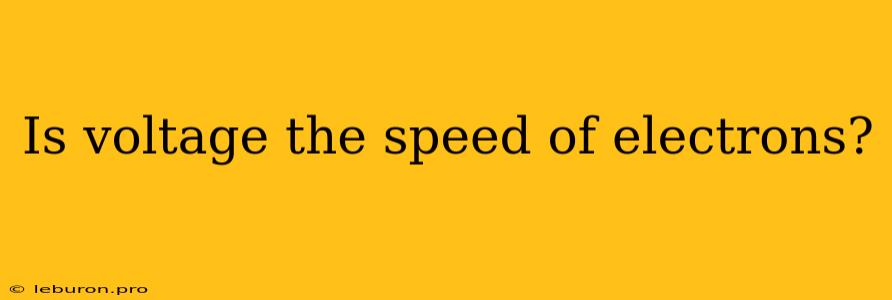The concept of voltage is often mistakenly associated with the speed of electrons. While electrons do move within a conductor, the voltage itself is not directly indicative of their speed. Instead, it represents the electrical potential difference between two points, driving the flow of electrons. This article will delve deeper into the relationship between voltage and electron movement, clarifying the distinction and explaining how they work together to create electric current.
Voltage: The Driving Force
Imagine a hill with a water reservoir at the top. The water at the top possesses potential energy due to its height, and this energy can be harnessed to do work. Similarly, voltage represents the potential energy difference between two points in an electrical circuit. This difference creates an electrical field, which acts as a force pushing electrons from the higher potential point towards the lower potential point.
The voltage is measured in volts (V), and it represents the amount of energy that a unit charge (like an electron) gains or loses when moving between two points.
Electron Movement and Current
The movement of electrons through a conductor due to the voltage difference is called electric current. The current is measured in amperes (A), and it represents the rate of flow of charge. Higher voltage creates a stronger electrical field, which pushes electrons faster, resulting in higher current.
However, the speed of individual electrons is not directly proportional to voltage. Electrons in a conductor are constantly in random motion, colliding with atoms and changing direction. The voltage merely provides a net direction for their movement, making them drift towards the lower potential point.
Drift Velocity vs. Current Velocity
It's important to differentiate between the drift velocity and the current velocity of electrons. Drift velocity refers to the average speed of electrons as they move through a conductor under the influence of an electric field. This speed is typically very slow, on the order of millimeters per second.
Current velocity, on the other hand, refers to the speed at which the electrical energy propagates through a conductor. This speed is much faster, approaching the speed of light.
Analogies and Misconceptions
To further clarify the concept, let's use some analogies:
-
Water Analogy: Imagine a pipe filled with water. The voltage is like the difference in water pressure between two points in the pipe. This pressure difference creates a flow of water, which is analogous to the current. The actual speed of the water molecules is much slower than the speed at which the pressure wave travels.
-
Highway Analogy: Consider a highway with cars traveling in one direction. The voltage is like the speed limit on the highway. It determines how fast the cars can travel, but not necessarily how fast they are moving at any given moment. The flow of cars on the highway is analogous to the current.
Conclusion
In summary, voltage is not the speed of electrons. It represents the electrical potential difference between two points, driving the flow of electrons and creating electric current. While higher voltage results in a faster current, the individual speed of electrons (drift velocity) is much slower and is not directly proportional to the voltage. The current velocity, which represents the speed of energy propagation, is much faster and is closer to the speed of light.
